
Suspended Animation #340
Gerald McBoing-Boing was a UPA animated short film, released November 2nd, 1950, which won the Oscar that year for Best Animated Short.
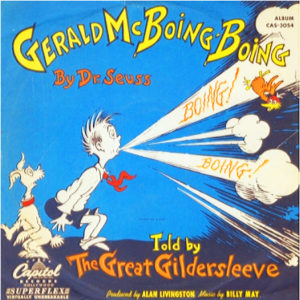 Adapted from a story by Dr. Seuss by storymen Phil Eastman and Bill Scott and directed by Robert Cannon, it was selected in 1995 for preservation in the United States Film Registry by the Library of Congress for being “culturally, historically or aesthetically significant”.
Adapted from a story by Dr. Seuss by storymen Phil Eastman and Bill Scott and directed by Robert Cannon, it was selected in 1995 for preservation in the United States Film Registry by the Library of Congress for being “culturally, historically or aesthetically significant”.
Gerald McCloy is a lonely and sad little boy who is ostracized by his peers because he can’t talk but can only communicate by producing a variety of sounds. However, at the end of the story, his disadvantage leads to personal success. It was an original rhyming six minute story created for a 1950 record released by Capitol Records.
Narrated by radio personality Harold Peary with music by Billy May, the novelty record was so popular that it was released in 1952 as a book with illustrations by Mel Crawford. Theodor Geisel (Dr. Seuss) sold the rights to UPA’s Stephen Bosustow for $500 to transfer the story to animation.
I got a chance to do a lengthy interview with Bill Scott on September 3rd, 1982, covering much of his career in animation – including his stint at UPA and his work on this short.
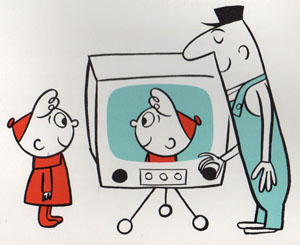 As Scott told me, “We changed a lot of the lines that were in there. Some of them were very much like Geisel and you couldn’t tell where Geisel leaves off and we started. It was a very successful picture and of course, it was fun to do.”
As Scott told me, “We changed a lot of the lines that were in there. Some of them were very much like Geisel and you couldn’t tell where Geisel leaves off and we started. It was a very successful picture and of course, it was fun to do.”
UPA produced three follow-up shorts: Gerald McBoing Boing’s Symphony (1953), How Now Boing Boing (1954), and Gerald McBoing! Boing! on Planet Moo (1956). In 1959, Abe Levitow directed Magoo Meets Boing-Boing (The Noise Making Boy) where Magoo is the babysitter for the young boy.
In 1956, a half-hour television series on CBS entitled The Boing-Boing Show was a showcase for UPA cartoons. A new 2005 Gerald McBoing-Boing cartoon series aired on the Cartoon Network.
Bill Scott: To begin with at UPA, you never mentioned Warners! That was the kiss of death. To be known as a Warner Brothers writer was to be known as a clothesline gag writer – you know just one gag hung right after another with lots of action and violence.
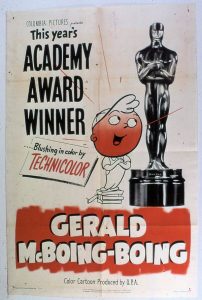 I had gotten a good recommendation from Phil Monroe and Bill Hurtz so I got in. I had worked for some of these people before. I did some inbetweening on Hell Bent for Election (1944) a big propaganda cartoon for Franklin D. Roosevelt.
I had gotten a good recommendation from Phil Monroe and Bill Hurtz so I got in. I had worked for some of these people before. I did some inbetweening on Hell Bent for Election (1944) a big propaganda cartoon for Franklin D. Roosevelt.
Steve Bosustow (later president of UPA) and Phil Eastman (UPA storyman and later children’s book writer/illustrator) had been involved with the film as well.
Gerald McBoing-Boing was my second project at UPA. I previously worked on the second Mr. Magoo short (Spellbound Hound, 1950). UPA wanted more cerebral in its approach. You had to be able to justify your humor. Very few of the directors were well versed in story.
Hub (John Hubley) wanted a story that was psychologically sound, sharp, satiric and if possible the story needed to have some sort of political slant. He would know what was good in a story when he saw it but couldn’t tell you how to get there. Bobe (Robert) Cannon wanted the humor to be gentle and the story to showcase movement that was almost choreographic.
Pete Burness was excellent on the Magoos that were the bread and butter of the studio. He was more in the style of Warners with fast movement and loved both verbal and visual jokes. We later used Pete at Jay Ward’s studio.
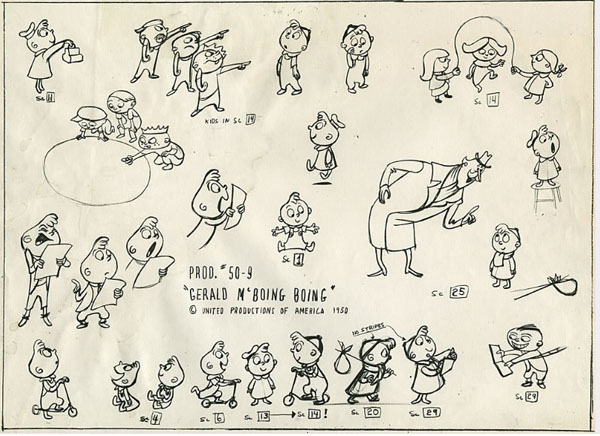
So it was natural that Bobe would be given McBoing-Boing but, boy, we had to fight him on some things like the parents rejecting their son. It was necessary in the story but he liked to avoid any type of conflict if at all possible.
My understanding is that there was some type of friendship between Steve Bosustow and Ted Geisel which is how we got the material. I thought the record was pretty funny. Phil and I were just given the record and told “See if you can make a cartoon out of this.” Geisel was not involved with the cartoon at all. He took the money and that was it.
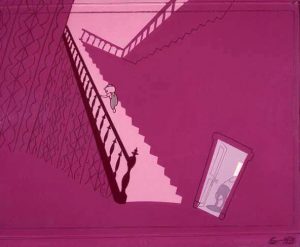 Phil and I had to look at it pretty closely to see what we could do to make the story more solid. There was really no ending to the story. It just goes along and suddenly he gets a job and that’s it. It ends with Peary doing his famous laugh that he used on radio.
Phil and I had to look at it pretty closely to see what we could do to make the story more solid. There was really no ending to the story. It just goes along and suddenly he gets a job and that’s it. It ends with Peary doing his famous laugh that he used on radio.
We had to look at it in a more psychological way in terms of what made the kid appealing and how to turn the handicap into an advantage like in Disney’s Dumbo. So we built up the rejections to make the ending more rewarding. The other rejections by his friends at school, by the doctor, the teacher and such were not enough to make him run away.
So our major embellishment was being rejected by his parents. Bobe hated that and tried to talk us out of it and we had to fight for it and we were finally able to convince the powers-that-be that it made sense. Bobe was very what I would call kind-hearted, maybe too kind-hearted. He finally accepted it because it would result in the happy ending.
 Also, you don’t get rich and famous and happy by being a sound effects man so Phil and I came up with that ending of the radio performance of Silent Sam Steelheart so he was an actor, a star. I loved that and telling the story just with sound.
Also, you don’t get rich and famous and happy by being a sound effects man so Phil and I came up with that ending of the radio performance of Silent Sam Steelheart so he was an actor, a star. I loved that and telling the story just with sound.
The radio actors in the studio are caricatures of Phil and animator Pat Matthews and others. We loved sneaking in things like that. It didn’t make any difference to the audience but it was fun.
People think it is just the original Seuss story but we did a lot of cutting and rearranging but kept the spirit. To me, Gerald looks like a kid that Phil Eastman would draw. The drawing of Gerald on the cover of the record isn’t appealing and looks nothing like the animation version who is very appealing.
We knew we had a rock solid story. At first I wasn’t happy with hiring Marvin Miller as the narrator but it turned out he was much better than I would have imagined.
While I enjoyed working on the short, I think one of my favorites while I was at UPA was The Tell Tale Heart (1953). I’d pick a phrase here and there and write Poe-like stuff to bridge the gaps. We were fortunate enough to get James Mason to narrate the story and I got to direct him. I told him where I thought this could be different and that could be different and he’d hit it perfectly. It was a thrill to sit there and listen to this stuff.


 Jim Korkis is an internationally respected animation historian who in recent years has devoted his attention to the many worlds of Disney. He was a columnist for a variety of animation magazines. With his former writing partner, John Cawley, he authored several animation related books including The Encyclopedia of Cartoon Superstars, How to Create Animation, Cartoon Confidential and Get Animated’s Animation Art Buyer’s Guide. He taught animation classes at the Disney Institute in Florida as well as instructing classes on acting and animation history for Disney Feature Animation: Florida.
Jim Korkis is an internationally respected animation historian who in recent years has devoted his attention to the many worlds of Disney. He was a columnist for a variety of animation magazines. With his former writing partner, John Cawley, he authored several animation related books including The Encyclopedia of Cartoon Superstars, How to Create Animation, Cartoon Confidential and Get Animated’s Animation Art Buyer’s Guide. He taught animation classes at the Disney Institute in Florida as well as instructing classes on acting and animation history for Disney Feature Animation: Florida.




















































“Working at UPA is largely a pain in the ass,” composer Lyn Murray wrote in his diary in 1956. “An atmosphere has somehow been created there that makes everyone feel completely unimportant.” He went on to complain about working on a film directed by “a nice bright fellow named Bill Scott who does a lot of bitching about how the properties we do have to conform to Bobe Cannon’s leanings towards Christian Science and his subservience to the PTA. Scott systematically took out all the poetry and charm.”
I’m not so sure that everyone at UPA felt unimportant. In fact, from what I’ve read there seems to have been a strong feeling of hubris pervading the studio — a sense of superiority to Warner Bros. and even Disney, to the point that Scott’s experience in the Art Davis unit was seen as something to be ashamed of. Scott himself was not immune to this attitude: as nice as it is to see my two favourite poets, Edgar Allan Poe and Dr. Seuss, mentioned in the same post, Scott’s remark that “you couldn’t tell where Geisel leaves off and we started” is laughably smug. Believe me, I can tell. It’s pretty obvious. Scott was a good writer, but when it came to writing poetry he simply wasn’t in the same league.
Of course I acknowledge the importance of UPA in animation history, but that said, with some exceptions I’m not a great fan of the studio’s output. The layouts and colour schemes remind me of my elementary school textbooks, and the soundtracks make me think of the filmstrips we used to watch. Billy May’s score to the Gerald McBoing Boing record brilliantly captures the rhythm and cadence of the Dr. Seuss verse, while with the cartoon score I keep expecting a “beep” telling me to advance to the next frame.
I had forgotten how different Gerald looked on Dr. Suess’ original record jacket compered to the simplified version used by UPA! He also looks much younger in the latter.